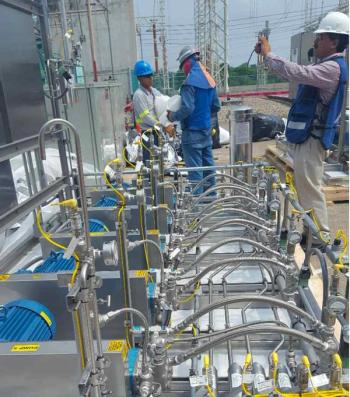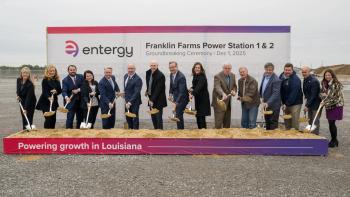
New 16 MW GE Turbine
GE’S NOVALT16 IS A 16.5 MW MACHINE AIMED AT THE PIPELINE COMPRESSOR AND POWER GENERATION MARKETS
GE has released the 16.5 MW NovaLT16, designed to provide 37% mechanical efficiency for pipeline compression and 36% efficiency for simple-cycle power generation. Further specs, according to GE, include 80% efficiency for combined heat and power, 99% availability and a guarantee of 25 ppm NOx. “Having a family of drivers below 20 MW opens up a more than $5 billion market, which adds 40% to 50% to the size of our potential business,” said Rafael Santana, President and CEO, Turbomachinery Solutions, GE Oil and Gas.
The NovaLT16, a two-shaft gas turbine with a power turbine speed of 7,800 rpm, is particularly suited to pipeline compression — with direct coupling to the latest generation of pipeline compressors. To further enhance its suitability for often-remote pipeline locations, it can attain 35,000 hours of mean time between maintenance (MTBM).
That adds up to four years of non-stop running for the gas generator module and eight years for the power turbine module. The NovaLT16 also enables short intervals for conducting maintenance activities. Modular maintenance means that a cold-condition engine can be swapped in 24 hours.
In addition to modular construction, the unit has easy access to auxiliary systems as well as wide lateral openings of the gas turbine’s enclosure, making maintenance and support more straightforward. Remote monitoring and diagnostics will be provided through GE’s Industrial Internet technology, diagnostic software, integrated data gathering and data transfer within its control panel.
The axial compressor has evolved from the GE MS5002E design with one stage added (taking it from 11 to 12) for improved efficiency and increasing the pressure ratio from 17:1 up to 19:1. Three variable geometry stages (IGV, S1 and S2) on the axial compressor provide for a wider speed range and surge control capabilities.
A rugged single annular combustor and 360° combustion casing for tighter clearance control were developed from the GE5 unit, which has a compact design. Also from the GE5, the NovalLT16 has 39 pre-mixers with double counter-rotating swirlers to improve air-fuel mixing. The turbine section’s 1st and 2nd High Pressure (HP) buckets are made of single crystal N4 material to improve durability while eliminating the need for thermal barrier coatings. The Low Pressure (LP) turbine has a variable-geometry nozzle for higher efficiency and improved emissions at part load (another feature that works well in pipeline applications with direct coupling).
“The NovaLT16 has benefited from our knowledge of aeroderivative and industrial gas turbines,” said Santana. “This has resulted in a lighter, more efficient turbine that requires lower maintenance like an aeroderivative while having the robustness of an industrial frame model.”
While a gas turbine typically has a development phase as long as ten years, Santana reported that this machine was developed in 30 months. This was made possible by using proven components from other models as well as the latest prototyping technologies such as 3D printing.
“3D printing enabled us to obtain parts in a matter of a few weeks rather than having to wait a year or more for a supplier to manufacture them,” said Santana.
Figure 2: GE NovaLT16 plant design[/caption]
He called attention to the bleed-down effect from GE Aviation. With safety and reliability being so heavily emphasized in aviation, Santana said that GE’s experience on the Leap turbofan engine has proven invaluable in the development of the NovaT16 in terms of better efficiency, lower lifecycle costs and rapid time to market.
“If you are trying to play in a market as it will be 10 years from now, you need a pretty good crystal ball,” said Santana. “Customers know what they need today and you have to provide it rapidly in order to take advantage of the window of opportunity.”
For oil and gas, the pipeline configuration is the result of a GE-TransCanada Corporation collaboration. The two companies have now signed a Memorandum of Understanding to progress development of the NovaLT16 gas turbine including technical evaluation, gas station layout optimization and negotiation of the terms and conditions for purchase.
“We strive to continue testing new technology that could result in cost savings and emission reductions within our facilities,” said David Montemurro, Vice President, Facilities and Pipeline Projects, TransCanada.
On the emissions front, the NovaLT16 achieves 25 ppm NOx or below over a range between 20% and 100% of the load. Seasonal combustion mapping is not required due to the design of the fuel system, the engine control and the combustion system.
“This collaboration with TransCanada has enabled us to develop a winning alternative for the oil and gas industry in North America,” said Santana. “We worked hard to provide it with the best in lifecycle costs, which equates to less than five days of maintenance stoppage over in 20 years.”
Development and testing of the NovaLT16 engine began in 2013. Completed units, including all auxiliaries systems and controls, are planned for release to the market in early 2016. The NovaT16 is the first of several units which will form part of a smaller turbine family within the GE portfolio. Additional smaller and larger MW machines will eventually be introduced.
Newsletter
Power your knowledge with the latest in turbine technology, engineering advances, and energy solutions—subscribe to Turbomachinery International today.





